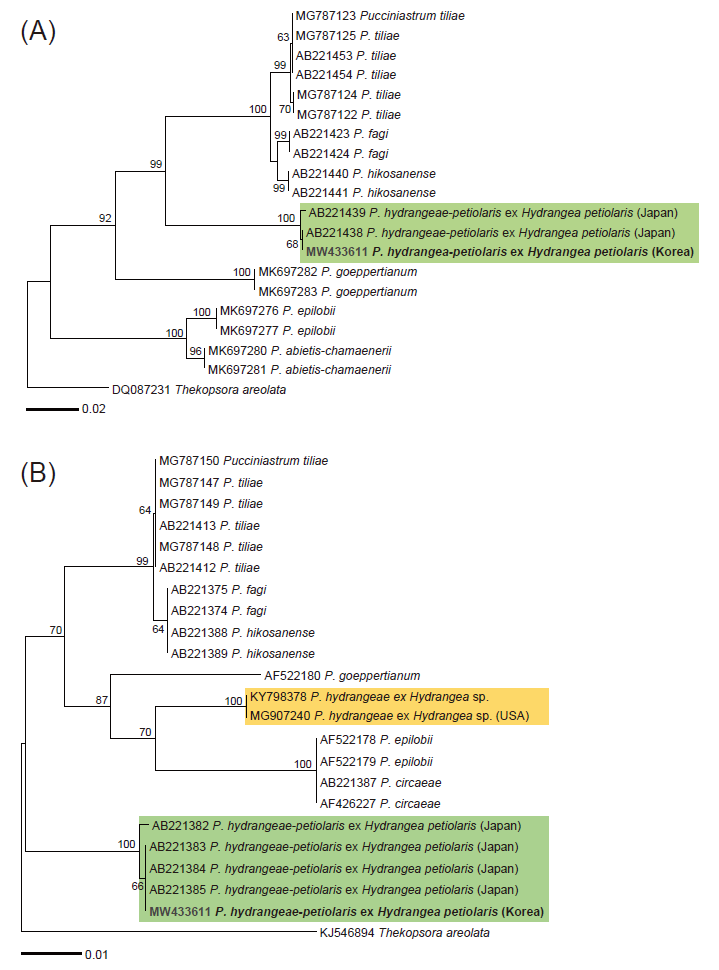등수국(Hydrangea petiolaris Siebold & Zucc.)은 수국과(Hydrangeaceae)에 속하는 식물로 한국이 원산지이며, 주로 울릉도, 제주도 등 남쪽 섬에 분포한다[1]. 등수국은 가지에서 기근이 발생하여 나무나 바위에 붙어 자라는 덩굴성 식물로 국외에서는 아이비, 담쟁이덩굴처럼 관상용 벽면 녹화소재로 많이 활용되고 있다[2]. 국내에서 등수국은 식물지리적으로 제한된 분포를 나타내며, 학술적, 생태학적으로 가치가 높아 식물구계학적 특정식물 III 등급 종으로 지정되었으나[3,4], 무분별한 채취로 자생지가 훼손되어 개체수가 감소하고 있는 실정이다[4].
지금까지 국내의 등수국에서 보고된 병해는 없으나, 해외의 경우 점무늬병균(Ascochyta hydrangeae, Septoria hydrangeae), 흰가루병균(Erysiphe polygoni, E. schizophragmatis), 탄저병균(Glomerella cingulata), 녹병균(Pucciniastrum hydrangeae-petiolaris) 등이 알려져 있다[5]. 전 세계적으로 Hydrangea속의 다양한 식물을 감염하는 녹병균은 두 종으로, 북미에서는 P. hydrangeae, 동아시아에서는 P. hydrangeae-petiolaris가 보고되었다[5-7]. 따라서, 한국의 등수국 녹병균이 어떤 종인지 확인이 필요하다. 이에 따라 본 연구진은 한국에서 유일하게 채집되어 고려대학교 식물표본보관소(KUS)에 보존된 등수국 녹병 시료(KUS-F30254, 채집일: 2017년 10월 24일, 채집장소: 제주시 조천읍 교래리, 33°23’04”N 126°37’22”E)를 대상으로 형태 및 분자계통분석을 수행하여 녹병균을 동정하였다.
건조표본에서 녹병균의 존재를 육안으로 확인하고, 해부현미경(M205C, Leica, Wetzlar, Germany)과 카메라(Dhyana 400DC, Tucsen, Fuzhou, China)를 이용하여 여름포자더미(uredinia)의 특징을 관찰 및 촬영하였다. 녹병균의 여름포자(urediniospore)의 형태적 특징을 파악하고 크기를 측정하기 위해 명시야광학현미경(BX53F; Olympus, Tokyo, Japan)을 사용하였으며, 광학현미경 사진은 미분간섭현미경(Axio Imager 2; Carl Zeiss, Oberkochen, Germany)과 Axiocam 512 color 카메라(Carl Zeiss, Oberkochen, Germany)를 이용하여 촬영하였다. 또한, 녹병균의 외부 형태와 미세구조는 주사전자현미경(SU8220; Hitachi, Tokyo, Japan)을 이용하여 관찰 및 촬영하였다.
녹병이 발생한 잎은 병 초기에는 연한 연두색 또는 노란색, 후기에는 갈색으로 변한다(Fig. 1A). 여름포자더미는 대부분 잎 뒷면에 형성되었지만 드물게 어린 줄기에서도 발견되었으며, 대부분 군데군데 흩어져 있었다(Fig. 1B and 1C). 노란색 내지 주황색으로 다소 돌출되었으며, 원형 내지 타원형에 가까운 모양으로 직경은 대부분 150-300 μm 범주에 들지만 드물게 2-3개의 여름포자더미가 연결된 듯 400-600 μm 길이로 형성된 경우도 있었다(Fig. 1D-1F). 여름포자(n=50)는 계란형 내지 타원형 또는 곤봉형이며, 크기는 20-26×15-20 μm (평균 23.09×17.9 μm)이며, 포자 벽의 두께는 0.8-1.5 μm였다(Fig. 1G-1I). 여름포자 표면에는 원뿔형의 미세한 돌기가 전체적으로 분포하였다(Fig. 1J-1N). 겨울포자(teliospore) 세대는 관찰되지 않았다. 이러한 형태적 특징은 일본의 등수국에서 보고된 Pucciniastrum hydrangeae-petiolaris Hirats.의 기록과 일치하였다[6].

Fig. 1. Pucciniastrum hydrangeae-petiolaris occurring on Hydrangea petiolaris . A, symptoms appeared on the upper surface of affected leaves. B, uredinia formed on the lower surface of an affected leaf. C-E, close-up view of erumpent uredinia. F-H, urediniospores observed under a DIC microscope: Urediniospores focused on outline (F and G), urediniospores focused on ornamentation (H). I-N, uredinium (I and L), urediniospores (J and M), and wall ornamentation of urediniospores (K and N) observed under a scanning electron microscope (SEM).
등수국 녹병균의 동정 및 Pucciniastrum 종들과 관계를 확인하기 위해서, internal transcribed spacer (ITS) 및 large subunit (LSU) rDNA 영역의 염기서열을 활용한 분자계통학적 분석을 수행하였다. 건조시료에서 채취한 여름포자에서 genomic DNA를 추출하였고, ITS5-u [8]와 LR6 [9] 프라이머를 사용하여 ITS와 LSU 영역을 동시에 PCR 증폭하였다. PCR 조건은 95℃에서 4분(initial denaturation), 95℃에서 40초(denaturation), 56℃에서 1분(annealing), 72℃에서 1분 20초(elongation), 72℃에서 7분(final elongation)이며, denaturation에서 elongation단계까지 36회 반복하여 진행하였고, 증폭 산물의 길이는 약 1,800 bp이다. 증폭된 PCR 산물을 전기영동하여 확인한 후, AccuPrep® PCR/Gel DNA Purification Kit (Bioneer, Daejeon, Korea)를 이용하여 정제하여 마크로젠(Macrogen, Seoul, Korea)에 염기서열 분석을 의뢰하였다. 증폭산물의 길이를 고려하여 총 4개의 프라이머, ITS5-u, ITS4-rust [10], LRust1R [10], LR6로 염기서열분석을 진행하였다. 분석된 염기서열은 DNASTAR computer package 7.1 (Lasergene, Madison, WI, USA)를 이용하여 편집 및 정리하여 NCBI (National Center for Biotechnology Information)의 GenBank에 등록하였다(MW433611). BLASTn을 이용하여 GenBank에 등록된 염기서열과 비교한 결과, ITS 영역 부위의 염기서열은 GenBank에 등록된 일본의 등수국 녹병균 P. hydrangeae-petiolaris의 염기서열 AB221438, AB221439와 각각 99.6%, 99.5%의 높은 상동성을 보였다. 또한 LSU 영역 부위의 염기서열은 AB221383과 100% 일치하였다. 계통학적 분석은 MEGA 7.0 program [11]을 이용하여 minimum evolution 방법으로 ITS 및 LSU 영역의 염기서열에 대한 계통수를 각각 작성하였으며(Fig. 2), 염기서열의 유전적 거리는 Tamura-Nei model로 계산하였고, bootstrap 분석은 1,000 반복으로 수행하였다. ITS와 LSU 영역의 계통수(Fig. 2A and 2B)에서 한국의 등수국 녹병균 시료는 일본에서 등록한 등수국 녹병균 P. hydrangeae-petiolaris와 100% 신뢰도지수로 한 그룹을 형성하였다. 반면, Hydrangea속을 감염하는 다른 녹병균인 P. hydrangeae와는 상당히 먼 계통학적 관계를 확인하였다(Fig. 2A).
수국속(Hydrangea)은 층층나무목(Cornales) 수국과(Hydrangeaceae)에 속하는 식물로서 전 세계 50여종이 알려져 있다[12,13]. 국내에는 자생종인 성널수국(H. luteovenosa), 등수국(H. petiolaris), 산수국(H. serrata f. acuminata), 꽃산수국(H. serrata f. buergeri), 떡잎산수국(H. serrata f. coreana), 탐라산수국(H. serrata f. ferillis)과 도입종인 미국수국(H. arborescens), 나무수국(H. paniculata), 수국(H. macrophylla f. otaksa) 등이 분포한다고 알려져 있다[14,15]. 우리나라에서 기록된 수국속의 녹병균으로는 산수국의 녹병균 Puccinia glyceriae가 있다. 본 연구를 통해 우리나라에서 발생하는 등수국 녹병을 처음으로 보고하고, 녹병균을 Pucciniastrum hydrangeae-petiolaris로 동정하였다.
본 연구를 통해 수국속을 감염하는 두 종의 녹병균, Pucciniastrum hydrangeae와 P. hydrangeae-petiolaris 사이에 상당한 계통학적 차이를 확인하였으며, 특히 등수국에서 P. hydrangeae-petiolaris의 확인은 일본과 러시아의 기록 이후로 처음이다. 추가적으로 동아시아 및 북미에서 다양한 수국속 식물을 감염하는 녹병균의 시료를 확보할 수 있다면, 녹병균(Pucciniastrum)-수국속(Hydrangea)의 진화적 관계를 밝히고, 녹병 관리를 위한 기초자료로서 활용가치가 높을 것으로 기대된다.

Fig. 2. Minimum evolution tree of Pucciniastrum species based on internal transcribed spacer (ITS) (A) and large subunit (LSU) (B) rDNA sequences. Bootstrapping support values higher than 60% are given above the branches. The two colored boxes represent the two Pucciniastrum species parasitic to Hydrangea species. The Korean specimen is indicated in bold. The scale bar equals the number of nucleotide substitutions per site.
적요
등수국은 수국과에 속하는 덩굴성 식물로 우리나라의 울릉도, 제주도, 남해안 섬에 분포한다. 2017년 10월 제주도에서 등수국에 발생하는 녹병균을 국내 최초로 발견하였다. 등수국 녹병균을 동정하기 위해, 형태적 특성을 조사하고 internal transcribed spacer (ITS) 및 28S large subunit (LSU) rDNA의 염기서열의 분자계통학적 분석을 수행하였다. 그 결과, 한국의 등수국 녹병균은 일본과 러시아에서 보고된 Pucciniastrum hydrangeae-petiolaris의 형태적 및 분자계통학적 특징과 일치하였으며, 북미에서 보고된 P. hydrangeae와는 상당히 먼 계통학적 관계를 보였다. 본 연구는 한국의 등수국에서 녹병균 P. hydrangeae-petiolaris의 첫 보고이다.


